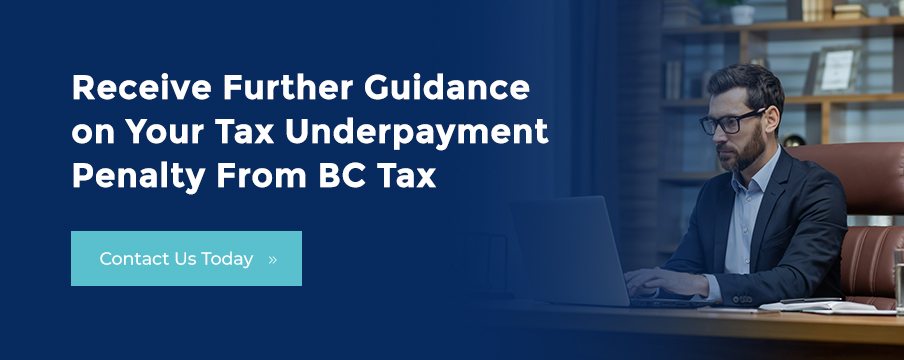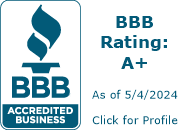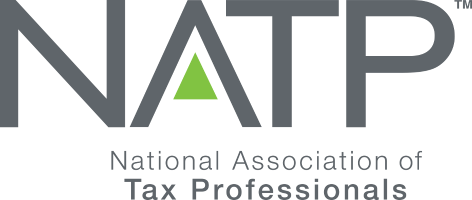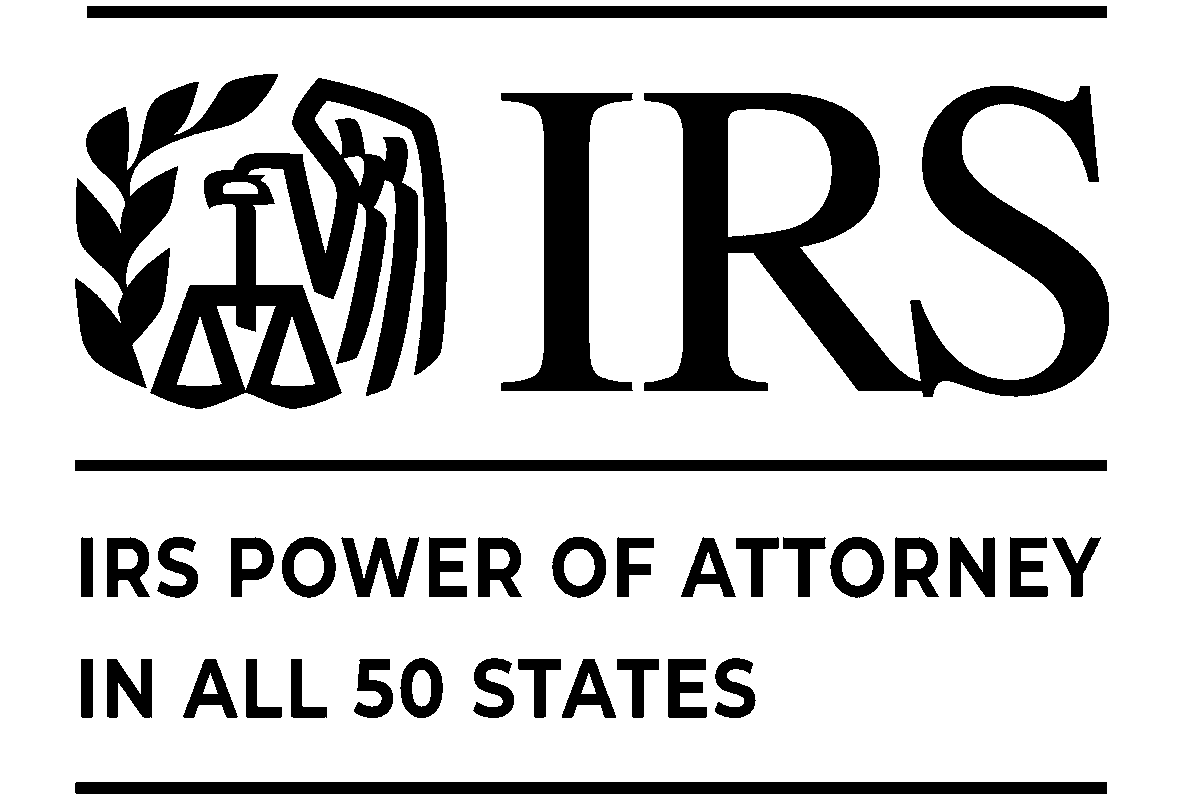
Whether you’re self-employed, a freelancer or a salaried employee, you must pay taxes on your income. When you can’t or don’t pay your taxes, you risk receiving a tax underpayment penalty from the IRS.
So, what is an underpayment penalty, and what are your options when you receive one? This guide explores everything you need to know about the underpayment of estimated tax, what you can do about it and how to avoid it in the future.
What Happens When You Underpay on Taxes
The IRS has a pay-as-you-earn (PAYE) policy, meaning taxpayers should pay their taxes throughout the year as they earn an income. If you owe more than $1,000 in taxes at filing, you may be at risk of receiving a tax underpayment penalty.
If the IRS sees you have unpaid taxes, they calculate a penalty and interest charges for you to pay. Paying taxes on time and addressing unpaid taxes is important to avoid these additional costs. If you ignore tax notices, the IRS may garnish wages or seize assets.
Generally, you’ll want to minimize tax underpayment by estimating your tax bill and making quarterly tax payments on the following dates:
- April 15
- June 15
- September 15
- January 15
You will know if you underpaid your taxes and owe a penalty if the IRS sends you a notice about the underpayment of estimated tax. In these situations, it can be valuable to consult with a licensed enrolled agent from BC Tax so they can negotiate with the IRS about your options.
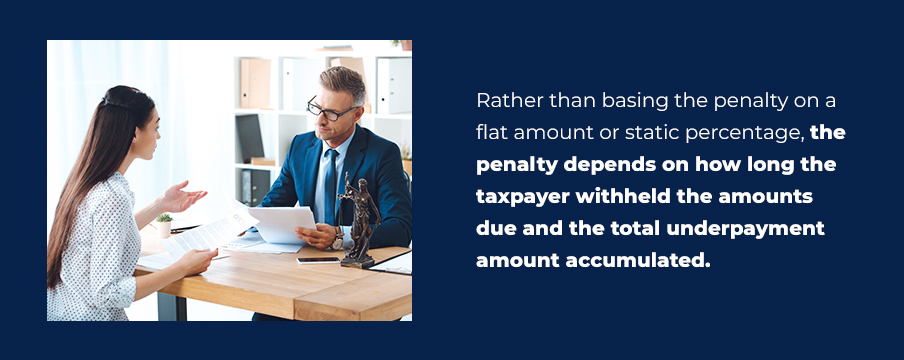
What Is an Underpayment Penalty?
The IRS demands a tax penalty when a taxpayer fails to pay the total estimated tax or refuses due payment. The IRS provides Form 2210 to help taxpayers determine whether they need to report underpayment and pay the penalty. This penalty helps the IRS encourage taxpayers to make accurate, timely and consistent tax payments.
The underpayment penalty varies depending on a taxpayer’s employment and income:
- Self-employment: Self-employed individuals must include the employer’s portion for Medicare and Social Security taxes when calculating their due payments.
- S corporate shareholders, sole proprietors and partners: These taxpayers should pay taxes in equal quarterly payments throughout the year due to their stable income.
- Uneven income: Some taxpayers, such as freelancers, may receive uneven income. This means they will need to pay varying amounts every quarter.
By using IRS Form 2210, these taxpayers can understand how to avoid the tax underpayment penalty. If they underpaid, they will need to pay the difference in addition to the penalty. Rather than basing the penalty on a flat amount or static percentage, the penalty depends on how long the taxpayer withheld the amounts due and the total underpayment amount accumulated.
Reasons an Underpayment Might Happen
You might be unable to pay your estimated tax on time for several reasons, including:
- You were unable to tax your Illness Benefit payments fully during the tax year.
- You and your spouse or partner separated or divorced, or your spouse or partner passed on, creating a need to adjust your tax credits or rate band.
- Your employment changed during the year and caused you to receive over 52 weeks of tax credits or rate bands on your income.
- The IRS missed the collection of tax credits and additional tax they needed to remove or reduce during the tax year.
- Your pension provider or employer used outdated revenue payroll information and applied an incorrect standard rate or tax credit to your income.
- You forgot to account for your pension or benefit income during the tax year.
- You forgot to tax pension or benefit income after receiving increased payments.
- You received pandemic wage subsidy support and found paying the full tax on this income challenging during 2020.
- Your payment frequency changed. For example, you may have gone from receiving income weekly to receiving it monthly.
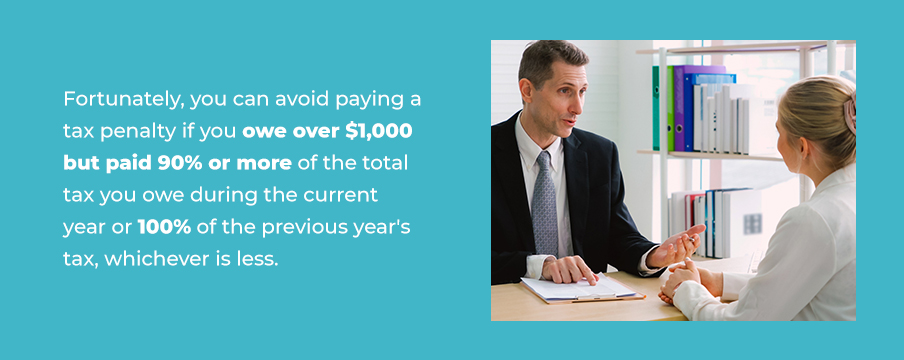
What Makes You Exempt From Estimated Tax Penalty
Fortunately, you can avoid paying a tax penalty in some situations, including:
- You owe less than $1,000 in taxes after accounting for credits, withholdings or pre-payments.
- You owe over $1,000 but paid 90% or more of the total tax you owe during the current year or 100% of the previous year’s tax, whichever is less.
- You are 62 or older and were retired during the current or prior tax year, and the underpayment was due to a reasonable cause rather than willful neglect.
- You became disabled during the current or previous tax year, and the underpayment was due to a reasonable cause rather than willful neglect.
- You experienced a noteworthy, unexpected or rare event such as a natural disaster or casualty.
How to Calculate Underpayment Penalty
Most taxpayers use IRS Form 2210 to determine their underpayment amount. Household employees, high-income taxpayers, farmers and fishers should refer to Form 1040. Generally, the IRS calculates the underpayment penalty based on the following factors:
- The underpayment amount
- The period since the underpayment was due
- The interest rate for the underpayment penalty
The interest rates for the penalty increase the amount you owe per quarter until your payments are complete. The date you need to start paying interest can also vary depending on the type of penalty you owe. The IRS underpayment penalties for the first quarter of 2023 are 7% for most individual underpayments and 9% for large corporation underpayments. An enrolled agent from BC Tax can help you file an amended return or qualify for penalty relief to help you reduce the interest you owe.
If IRS Form 2210 doesn’t apply to you, you can either calculate the penalty yourself or allow the IRS to calculate it for you. You can find out how much an underpayment penalty is yourself by:
- Determining the federal short-term rate for the quarter.
- Adding 3% to the determined amount.
It’s best to let the IRS calculate your penalty if:
- Box B, C or D of Part II in Form 2210 doesn’t apply to you.
- Your withheld tax amount isn’t enough by the end of the tax year.
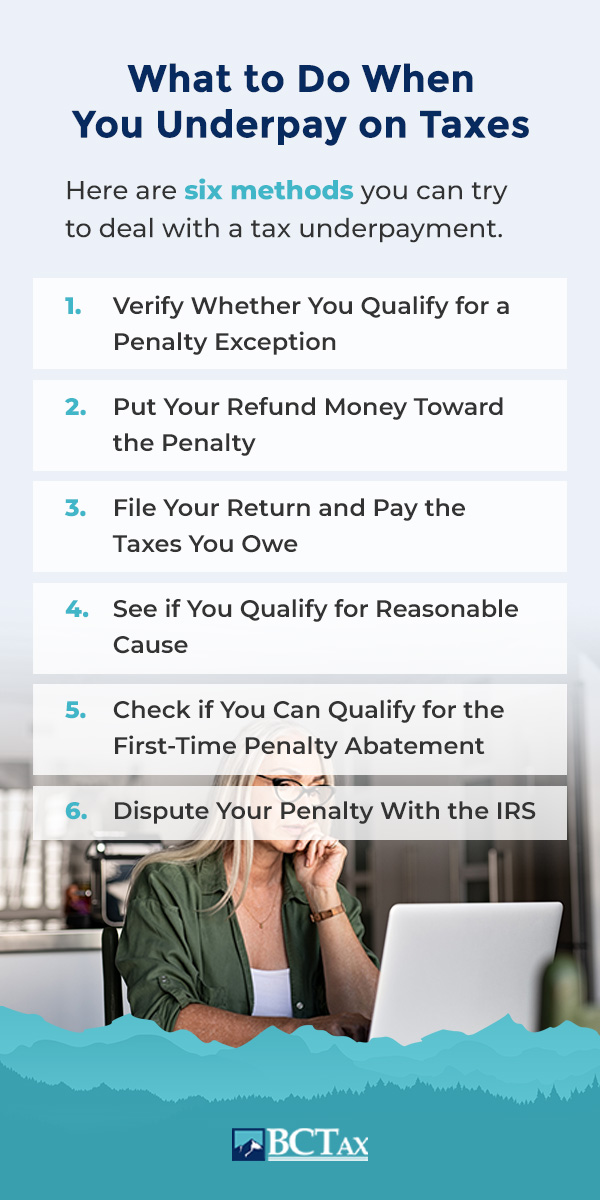
What to Do When You Underpay on Taxes
Act quickly if you notice you have underpaid your taxes. If you wait to deal with the situation, you may receive larger penalties or find it more challenging to pay what you owe. Reading this guide is a helpful first step in the right direction.
From qualifying for exceptions to finding ways to pay underpaid taxes immediately, you can take various actions to improve your situation. Here are six methods you can try to deal with a tax underpayment.
1. Verify Whether You Qualify for a Penalty Exception
If you underpaid but haven’t received a tax underpayment penalty, check if you qualify for an exception. You may qualify for an exception for several reasons, such as if the underpaid amount is less than $1,000 when you file or circumstances beyond your control, like a natural disaster, prevented you from making a quarterly payment.
2. Put Your Refund Money Toward the Penalty
If you have paid the taxes due but need money to pay your penalty and expect a refund, put the refund money toward the penalty. When you avoid taking care of a penalty right away, you may need to pay more money toward the penalty due to accumulating interest or even receive additional fines. It’s best to pay a penalty as soon as possible, even if you initially plan to use your refund money for something else.
3. File Your Return and Pay the Taxes You Owe
Try paying the taxes you owe when filing your return. While quarterly payments are due on April 15, June 15, September 15 and January 15, you still need to file your annual return in April. Taxes you owe past April usually accumulate penalties and interest, causing you to owe even more than you initially thought. You can avoid additional penalties by paying existing fines and any taxes due when you file your annual return.
Additionally, BC Tax can help you file an extension if paying the penalty proves too challenging by April. An extension allows you to avoid the failure-to-file penalty. This penalty is set at 5% on the taxes you owe for each month you delay your return and may go up to 25%, meaning the bill may get larger for you very quickly.
4. See if You Qualify for Reasonable Cause
Sometimes, you may be unable to pay the taxes you owe or file your return on time due to circumstances beyond your control. In these situations, the IRS may waive your penalty as part of Reasonable Cause. Some examples that help you qualify for Reasonable Cause include:
- House fires
- Serious illness
- Natural disasters
- Death of an immediate family member
- Inability to obtain the necessary documentation
Depending on your reasoning, the IRS may accept other reasons if you can prove the situation was beyond your control and that you acted responsibly. This requires accurate information about what happened, where it occurred, when it occurred, how the events made you unable to meet daily responsibilities and how you handled the situation after realizing it would be challenging to meet obligations. You will also need to provide documentation, such as a letter from a professional confirming your situation or court records.
5. Check if You Can Qualify for the First-Time Penalty Abatement
You may qualify for a first-time penalty abatement if it is your first time being subject to a tax penalty and you normally meet all filing and payment due dates. Three main factors the IRS will consider to determine whether you qualify include the following:
- You filed all your tax returns.
- You received zero penalties in the past three years.
- You agree to set up an installment agreement with the IRS or pay the outstanding balance.
6. Dispute Your Penalty With the IRS
Rarely, you may receive a penalty based on incorrect written advice from the IRS. In this case, you can dispute the penalty by submitting a statement explaining how the advice led to a penalty. You may be eligible to dispute your penalty if you meet the following criteria:
- The IRS provided written advice in direct response to your request for advice.
- The incorrect written advice was not due to misinformation in your written request for advice.
- You received a penalty based on the IRS’s written advice that you relied on.
When submitting your statement to dispute a penalty, include a copy of your written request for advice, the IRS’s written response and any supporting documents.
How to Avoid the Underpayment Penalty
You can try a few things to avoid future tax underpayment penalties.
First, estimate the total amount of taxes you’ll owe for the entire year and divide that total by four to calculate your estimated quarterly tax. Pay this estimated amount to the IRS each quarter. This can be ideal for taxpayers with steady income throughout the year.
Start by establishing your income for the previous tax year, and ensure your estimated quarterly payments add up to 100% of what you paid for that year. Remember to factor in any credits or deductions you qualify for when adding up the payment amount.
The best strategy for helping you prevent future tax underpayment penalties involves working with a qualified professional who can provide you with the advice and information you need to stay on the right track. An enrolled agent from BC Tax can help you with tax preparation and resolution to make your tax processes smoother.
Receive Further Guidance on Your Tax Underpayment Penalty From BC Tax
Paying taxes is an important responsibility, and handling underpayments and penalties head-on before your fine gets larger is best. By working with a skilled enrolled agent from BC Tax, you may be able to reduce or eliminate penalties and interest.
BC Tax is a tax consultation agency that offers various tax-related services, from tax resolution to tax relief. If you require any tax advice, we want to help. Contact a professional from BC Tax online today, or call 1-800-548-4639 for extra guidance on your next step in dealing with a tax underpayment.

 1-800-548-4639
1-800-548-4639